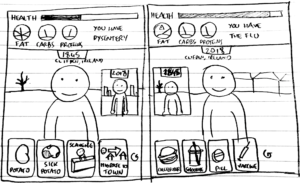“How do I successfully conduct a brainstorm session?”, is a question you may ask yourself…
As a first for our blog, we’re going to shed some key lessons learned while organizing brainstorm sessions for our clients seeking to discover new concepts for games or for other applications of game technology. Going all the way back to 2010, we’ve learned a thing or two during these brainstorm sessions, and we’re happy to offer some insight in how we do it.
Lesson 1: Most Projects Benefit from Brainstorming
When embarking on a new game development adventure, you’re often very excited to start prototyping right away to try out an attractive sounding idea. However, without additional steps, it’s hard to tell whether there’s an other idea within reach that may be significantly better.
The solution is to widen your perspective and consider more ideas. Since the amount of possible concepts to fit your desires may be theoretically infinite, this may sound like a daunting task. By conducting a formal brainstorm session, you can discover many possible concepts, after which you can put the most promising ideas to the test by developing a few prototypes.

Sketch for one of the ideas generated during a brainstorm session for a game about the Irish Famine – which we ended up prototyping.
Lesson 2: Use a Separate Requirements Session to Gain and Share Insights on what you’re after
To be able to brainstorm freely, it’s important to define constraints. This sounds like a contradiction, but once you’ve succinctly defined what you’re going after, you can forget all the rest and go crazy when it comes to idea generation.
Also, when involving other creative minds in a brainstorm session, you’ll want to make sure to get on the same page regarding what matters.
Getting the requirements straight can be done by formally writing down the ultimate goal of the project, to look at what should definitely be included, and what is no-go territory. It’s a bit like going over the rules of a sport before we start playing: we set up a playing field and go over the dos and don’ts. Within these rules, we can can let our imagination go free.
To be able to keep this mind while brainstorming, it helps if you’re able to limit them to two short bullet point lists – one for the requirements, and one for any nice to have aspects.
Lesson 3: Delay your Judgement to get into an Unstoppable Idea Generation Mode
Now that we know the rules, we can play the brainstorming game. In order to be good at this game, it’s important to know that the more ideas you generate, the higher the likelihood that a truly genius idea emerges.
While generating ideas, a moderator encourages everyone to chip in. The moderator writes down key aspects of the ideas on a shared screen to help everyone to see the ideas that are being generated. This inspires participants to add to the ideas, or to express any of their own ideas that come up. In a brainstorm session, it’s all about adding to ideas – not about subtracting from them.
As long as the ideas fit the requirements, nothing is off limits. Ideas can be funny, ambitious, seemingly simple or overly complex, something you’ve seen before, or something unlike anything you’ve ever heard of. Again, the key is to generate as many ideas as possible. If you’re not generating plenty of bad ideas during a brainstorm, you’re probably not being open minded enough – and an open mind is exactly what you need to be able to coincidentally run into a truly genius idea.

In some brainstorm sessions, we use inspirational images. This image of a leadlight at the Quinnipiac University Irish Great Hunger museum was particularly inspirational as it visualizes some of the differences before (left side) and during the famine (right side).
Lesson 4: Use a Simple Voting System to Weed through Ideas
In order to allow for a first selection of the best ideas, we use a simple voting system, which works as follows:
• Go over the notes with all the ideas that were generated. For each idea, agree on whether it should be merged with other ideas that came up during the brainstorm session or whether it’s an idea of its own, and give it a name and a number for simplicity’s sake.
• Share these notes with everyone, and instruct everyone to come up with a top 5 or 10 of their most favorite ideas, while giving their highest ranking idea the highest score (e.g. 5 points), the second highest idea 4 points, and so on. It is crucial for everyone to do this separately, in order to avoid participants influencing each other’s opinions.
• Add up everyone’s scores for each concept and sort the concepts by score.
The highest scoring concepts win. Usually, at some point, there’s a bigger drop in score, which can be useful when deciding which concepts should be kept.
Lesson 5: Don’t wait too Long before Elaborating the Chosen Few
After squeezing the creative juices out of everyone, you may feel tempted to give it a break – and let some of the ideas sit in order to be able to use some hindsight to see which ones stand out.
To be able to do this, you still want to elaborate on the ideas first, so you can capture the initial excitement from the brainstorm session as well as your most vivid memories of the discussion in order to complete each of the selected ideas to a point where they feel like complete concepts that cover the key requirements.
At PreviewLabs, as we complete the concepts for our clients, we summarize them in a brainstorm report. This allows the ideas to be considered later on.
Lesson 6: Give it some Time before Deciding which Concepts to Prototype
But not too long! Our programmers need to eat.
Jokes aside – it can be important to get rid a bit of that initial overexcitement key to generating new ideas. Maybe some of these ideas you came up with aren’t as good after all. Wait a week or two, and then read over them once more to see which ones still feel as if they’ve got some serious potential. Those are the ones you’ll want to prototype to find out wether they really have this potential and which one shines the most!
Need to Come up with some Concepts?
We’ve got your Back
Whether you need concepts for a game, educational game, or some fancy new way of using VR or AR – we can organize a brainstorm session for you while relying on our experience organizing them for the past ten years. And if you’d happen to need a prototype a few of these concepts afterwards, we’ve got your more than covered. Get in touch through our contact form to start the conversation.
